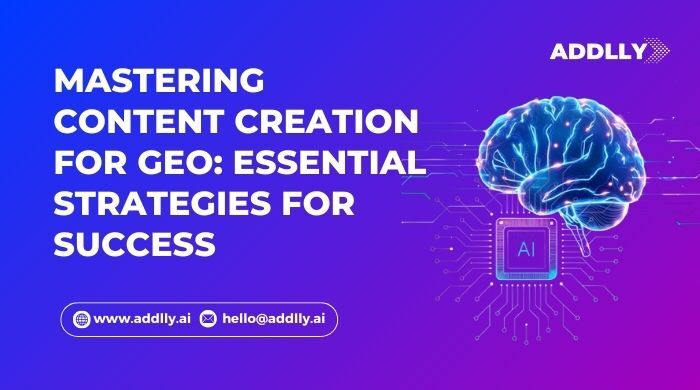Search has entered a new era. Traditional search engines like Google have long relied on algorithms that reward keyword optimization, backlinks, and technical SEO tactics. But with the rise of AI-powered search engines and generative AI tools, the rules are shifting. Instead of scrolling through search engine results pages, users are increasingly presented with AI-generated responses that provide direct answers to their queries.
This shift creates both challenges and opportunities for brands. If your content is not optimized for Generative Engine Optimization (GEO), it risks being invisible in AI search results. But if you adapt your content creation strategy to GEO, your brand can remain visible in a world where AI models process information differently from traditional search algorithms.
The big question is: how do you create content that both human readers and AI search engines understand?

Quick Summary – Content Creation for GEO
Mastering content creation for GEO means adapting content to be understood by both human readers and AI-powered search engines. Unlike traditional SEO, which targets search engine results pages, GEO focuses on inclusion in AI-generated answers. Success depends on content quality, structured data, semantic search, and aligning with user intent. Brands that embrace GEO early can secure greater visibility in an AI-driven search landscape. Key takeaways include:
- What makes GEO content different from traditional SEO content.
- How to audit your website using Addlly AI’s GEO Audit Tool.
- How to optimize for search intent, clarity, and conversational queries.
- Why structured data, semantic phrasing, and fresh updates matter.
- Best practices to balance human readability with AI comprehension.
- Practical steps to increase visibility in AI-generated answers.
If your brand wants to stay visible in AI search, content needs to be built for how generative engines read, select, and summarize information, not just for how Google ranks links.
Understanding Content Creation for GEO
Content creation for GEO means producing material that is optimized not just for traditional SEO, but also for the unique way that AI-driven search engines and generative engines interpret, summarize, and deliver information. In traditional SEO, success was about ranking higher on search engine results pages (SERPs). With GEO, success is about ensuring your brand is cited or included in AI-generated answers, the summaries and insights provided directly by tools like Google’s AI Overviews or Bing Copilot.
Instead of chasing clicks alone, GEO prioritizes content that:
- Understands user intent and delivers high-quality, concise information.
- Is structured in a way that AI crawlers and large language models can process.
- Remains useful and trustworthy for both human readers and AI-powered tools.
How GEO Differs From Traditional SEO?
Traditional SEO relies on tactics like keyword optimization, backlinks, and schema markup to influence rankings. While these strategies still matter, GEO introduces new priorities:
- From Keywords to Intent: Traditional SEO often focused on keyword stuffing. GEO emphasizes semantic search, long tail keywords, and writing for search intent rather than exact keyword matches.
- From SERPs to AI Answers: Instead of competing for a spot on the first page of search engine results, GEO aims for inclusion in AI-generated responses that dominate the top of AI-powered search environments.
- From Links to Content Quality: Backlinks are less influential than before. AI systems care more about content quality, trust, and authority.
For example, if someone searches “best skincare routine for dry skin,” a traditional search engine might list 10 links. An AI search tool will generate a summarized routine with brand mentions, leaving only a few visible. GEO ensures your content is structured so it’s more likely to appear in that answer.
Read our blog on: Best Practices For GEO Content Creation That Rank in AI
Key Elements of Content Creation for GEO
Creating content for GEO means going beyond traditional search engine optimization. To rank in AI-generated search results from tools like ChatGPT, Perplexity, and Gemini, your content must be structured, informative, and easy to process, for both humans and AI. Here, we outline the key elements of AI content creation that improve your chances of being cited, from schema markup and semantic search to optimizing for search intent and natural language.
1. Focus on Content Quality for Both AI and Human Readers
AI engines reward high-quality content that satisfies user behavior patterns and engagement metrics. Your content must:
- Be easy for human readers to consume.
- Provide concise explanations that AI models can easily summarize.
- Avoid keyword stuffing while still including relevant keywords and phrases.
For example, if writing about “organic coffee benefits,” instead of repeating the keyword, explain the science behind antioxidants, cite research, and provide context. This makes your article valuable to both AI engines and humans.
2. Structure Content With Schema and Data
Structured data and schema markup play a crucial role in how search engine crawlers and AI crawlers interpret web pages. Adding product, FAQ, or review schemas can increase the chance that generative engines pull your content into AI-generated answers or rich results.
3. Write for Search Intent and User Queries
AI search engines prioritize content that aligns with user intent. Identify the search queries your target audience is asking, and structure your content to provide direct answers. For instance, FAQ sections or Q&A-style formatting can increase visibility in AI search results.
Read our guide on: Future Trends in GEO
4. Use Natural Language and Semantic Search
AI comprehension depends on natural language. Instead of forcing in exact keywords, use conversational phrasing that reflects how people speak. This aligns with voice search queries and helps AI models process information more effectively.
5. Keep Content Fresh and Updated
Generative AI engines rely on both training data and real-time updates from the web. Keeping your content fresh ensures that AI search tools see your site as a relevant source for current search behavior and search trends.
Read about: What is AI Search Visibility
Best Practices for Content Creation for GEO
Writing for Generative Engine Optimization (GEO) isn’t about stuffing keywords. It’s about meeting how AI powered search interprets content. To show up in AI-generated answers, your content needs to be clear, relevant, and aligned with real search queries. From structuring content for AI crawlers to keeping language natural and updated, this section covers GEO content creation best practices that you must include in your content strategy to boost both visibility and usability.
1. Prioritize Clarity and Relevance
AI-driven search engines interpret context, meaning, and intent. This means your content should be easy to understand and directly relevant to the user’s query. Avoid jargon unless your audience expects it, and always aim for concise explanations supported by clear examples. A well-structured article that anticipates questions and provides direct answers is more likely to surface in AI-generated results.
2. Optimize for Conversational Queries
Generative engines don’t just rely on keywords; they respond to natural language. Instead of only targeting short, keyword-heavy phrases, structure your content around questions your audience might actually ask. Incorporating headings like “How does…?” or “What is the best way to…?” makes it easier for AI systems to match your page to real-world search patterns.
3. Provide Comprehensive Coverage
AI models reward depth. A shallow overview may get lost in competitive results, but in-depth, well-researched content is more likely to be featured. Expand on your topics with context, comparisons, and practical applications. Include supporting details such as statistics, step-by-step guides, or case examples that give AI more signals of authority and usefulness.
4. Use Structured Data and Formatting
Clear formatting isn’t just for human readers; it helps AI systems parse information efficiently. Use bullet points, numbered lists, tables, and schema markup to highlight relationships and hierarchy in your content. When your content is structured this way, it increases the chance of being included in AI-generated summaries or featured snippets.
5. Refresh and Update Regularly
Generative search engines weigh freshness heavily. Outdated information can quickly harm your visibility. Make it a habit to audit your content regularly, updating statistics, examples, and references. Highlight recent developments in your field, ensuring your content continues to align with what AI engines consider relevant and trustworthy.
6. Balance Human Voice with AI Optimization
While it’s important to meet AI’s technical requirements, never sacrifice your brand’s unique tone. AI may prioritize clarity and context, but human readers still value personality and authenticity. Aim for a balance where your content is both algorithm-friendly and genuinely engaging to people.
Addlly: Putting GEO Into Practice
The real key to success with Generative Engine Optimization lies in combining these best practices into a consistent strategy. Clear, structured, and in-depth content signals authority to AI systems while delivering real value to readers. If you’re unsure where to begin, our AI Search Audit is designed to show you exactly how your content performs in today’s AI-driven landscape. We’ll identify gaps, highlight opportunities, and provide practical steps to make your website GEO-ready, helping you stay ahead in an environment where traditional SEO alone is no longer enough.
FAQs – Mastering Content Creation for GEO
What is GEO in SEO?
GEO stands for Generative Engine Optimization, a practice that helps content appear in AI search results and AI-generated responses from modern search engines.
How is GEO Different from Traditional SEO?
Traditional SEO focuses on search engine rankings and traffic from SERPs. GEO emphasizes how AI models and generative engines select and summarize information to provide direct answers.
Why Does Structured Data Matter for GEO?
Structured data helps AI crawlers and search engine algorithms understand your content better, making it more likely to appear in AI-generated answers or AI search results.
How Can I Optimize Content for GEO?
Focus on content quality, semantic search, long-tail keywords, user intent, and keeping pages fresh. Avoid keyword stuffing and prioritize content that benefits both humans and AI comprehension.
Do Traditional SEO Tactics Still Help in GEO?
Yes. Elements like keyword optimization, internal linking, and schema remain important. However, GEO requires an added focus on how AI search engines process and deliver content.


